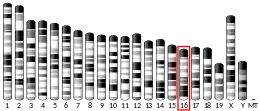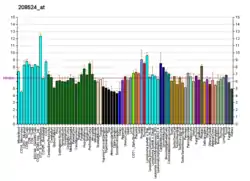| GPR15 | |||||||||||||||||||||||||||||||||||||||||||||||||||
|---|---|---|---|---|---|---|---|---|---|---|---|---|---|---|---|---|---|---|---|---|---|---|---|---|---|---|---|---|---|---|---|---|---|---|---|---|---|---|---|---|---|---|---|---|---|---|---|---|---|---|---|
| Identifiers | |||||||||||||||||||||||||||||||||||||||||||||||||||
| Aliases | GPR15, BOB, G protein-coupled receptor 15 | ||||||||||||||||||||||||||||||||||||||||||||||||||
| External IDs | OMIM: 601166 MGI: 1918473 HomoloGene: 3869 GeneCards: GPR15 | ||||||||||||||||||||||||||||||||||||||||||||||||||
| |||||||||||||||||||||||||||||||||||||||||||||||||||
| |||||||||||||||||||||||||||||||||||||||||||||||||||
| |||||||||||||||||||||||||||||||||||||||||||||||||||
| |||||||||||||||||||||||||||||||||||||||||||||||||||
| |||||||||||||||||||||||||||||||||||||||||||||||||||
| Wikidata | |||||||||||||||||||||||||||||||||||||||||||||||||||
| |||||||||||||||||||||||||||||||||||||||||||||||||||
G protein-coupled receptor 15 is a protein that in humans is encoded by the GPR15 gene.
GPR15 is a class A orphan G protein-coupled receptor (heterotrimeric guanine nucleotide-binding protein, GPCR). The GPR15 gene is localized at chromosome 3q11.2-q13.1.[5][6] It is found in epithelial cells,[7] synovial macrophages,[8] endothelial cells [9] and lymphocytes especially T cells. From the mRNA sequence a 40.8 kD molecular weight of GPR15 is proposed. In an epithelial tumour cell line (HT-29), however, a 36 kD band, composed of GPR15 and galactosyl ceramide, was detected. [7] Protein expression in lymphocytes is strongly associated with hypomethylation of its gene. [10]
Tissue distribution
High gene expression was described for colonic mucosa, small bowel mucosa, liver and spleen. Moderate gene expression was found in blood, lymph node, thymus, testis and prostate. [7][11] In peripheral blood, GPR15 is mainly found on T cells, especially on CD4+ T helper cells, and less prominent on B cells. [12]
By immunohistochemistry GPR15 is found specifically in glandular cells of the stomach, α-cells of islet of Langerhans in pancreas, surface epithelium of small intestine and colon, hepatocytes in liver, tubular epithelium of the kidney and in diverse tumour tissues such as glioblastoma, melanoma, small cell lung carcinoma or colon carcinoma.
Function
The overall physiological role remains elusive. It seems to play a role in homing of single T cell types to the colon. In human, GPR15 controls together with α4β7-integrin the homing of effector T cells to the inflamed gut of ulcerative colitis. [13] With respect to the homing of GPR15-expressing immune cells to the colon there are divergent mechanisms between human and rodents like mouse. [14]
Ligands
There are at least two endogenous ligand found recently. One ligand encoded by the human gene GPR15LG was identified as a robust marker for psoriasis whose abundance decreased after therapeutic treatment with anti-interleukin-17 antibody. Transcripts of GPR15LG are abundant in cervix and colon. It is currently unknown whether GPR15LG causes disease symptoms or is the consequence of a disturbed epithelial barrier. It does not act as a chemotactic agent but rather decrease T cell migration suggesting a mechanism of heterologous receptor desensitization. [15]
The second ligand is a fragment of thrombomodulin exerting anti-inflammatory function in mice. [9]
Clinical significance
Human GPR15 was originally cloned as a co-receptor for HIV or the simian immunodeficiency virus. [11] HIV-induced activation of GPR15 in enterocytes seems to cause HIV enteropathy accompanied with diarrhea and lipid malabsorption. [7]
In inflammatory bowel diseases (IBD) such as Crohn’s disease and ulcerative colitis the proportion of GPR15-expressing cells among regulatory T cells is slightly increased in peripheral blood. [13] In mouse, GPR15-deficient mice were prone to develop severe large intestine inflammation, which was rescued by the transfer of GPR15-sufficient T regs. [16]
Lifestyle
Chronic tobacco smoking is a very strong inducer of GPR15-expressing T cells in peripheral blood. Although the proportion of GPR15-expressing cells among T-cells in peripheral blood is a high sensitive and specific biomarker for chronic tobacco smoking [12] it does not indicate a disturbed homeostasis in the lung. [17]
References
- 1 2 3 GRCh38: Ensembl release 89: ENSG00000154165 - Ensembl, May 2017
- 1 2 3 GRCm38: Ensembl release 89: ENSMUSG00000047293 - Ensembl, May 2017
- ↑ "Human PubMed Reference:". National Center for Biotechnology Information, U.S. National Library of Medicine.
- ↑ "Mouse PubMed Reference:". National Center for Biotechnology Information, U.S. National Library of Medicine.
- ↑ Heiber M, Marchese A, Nguyen T, Heng HH, George SR, O'Dowd BF (March 1996). "A novel human gene encoding a G-protein-coupled receptor (GPR15) is located on chromosome 3". Genomics. 32 (3): 462–465. doi:10.1006/geno.1996.0143. PMID 8838812.
- ↑ "Entrez Gene: GPR15 G protein-coupled receptor 15".
- 1 2 3 4 Clayton F, Kotler DP, Kuwada SK, Morgan T, Stepan C, Kuang J, et al. (November 2001). "Gp120-induced Bob/GPR15 activation: a possible cause of human immunodeficiency virus enteropathy". The American Journal of Pathology. 159 (5): 1933–1939. doi:10.1016/S0002-9440(10)63040-4. PMC 1867054. PMID 11696454.
- ↑ Cartwright A, Schmutz C, Askari A, Kuiper JH, Middleton J (June 2014). "Orphan receptor GPR15/BOB is up-regulated in rheumatoid arthritis". Cytokine. 67 (2): 53–59. doi:10.1016/j.cyto.2014.02.015. PMC 3996549. PMID 24725539.
- 1 2 Pan B, Wang X, Nishioka C, Honda G, Yokoyama A, Zeng L, et al. (April 2017). "G-protein coupled receptor 15 mediates angiogenesis and cytoprotective function of thrombomodulin". Scientific Reports. 7 (1): 692. Bibcode:2017NatSR...7..692P. doi:10.1038/s41598-017-00781-w. PMC 5429650. PMID 28386128.
- ↑ Bauer M, Linsel G, Fink B, Offenberg K, Hahn AM, Sack U, et al. (2015). "A varying T cell subtype explains apparent tobacco smoking induced single CpG hypomethylation in whole blood". Clinical Epigenetics. 7 (1): 81. doi:10.1186/s13148-015-0113-1. PMC 4526203. PMID 26246861.
- 1 2 Deng HK, Unutmaz D, KewalRamani VN, Littman DR (July 1997). "Expression cloning of new receptors used by simian and human immunodeficiency viruses". Nature. 388 (6639): 296–300. doi:10.1038/40894. PMID 9230441. S2CID 4369660.
- 1 2 Bauer M, Hackermüller J, Schor J, Schreiber S, Fink B, Pierzchalski A, Herberth G (May 2019). "Specific induction of the unique GPR15 expression in heterogeneous blood lymphocytes by tobacco smoking". Biomarkers. 24 (3): 217–224. doi:10.1080/1354750X.2018.1539769. PMID 30387691. S2CID 53289288.
- 1 2 Fischer A, Zundler S, Atreya R, Rath T, Voskens C, Hirschmann S, et al. (October 2016). "Differential effects of α4β7 and GPR15 on homing of effector and regulatory T cells from patients with UC to the inflamed gut in vivo". Gut. 65 (10): 1642–1664. doi:10.1136/gutjnl-2015-310022. PMC 5036234. PMID 26209553.
- ↑ Bilsborough J, Viney JL (February 2015). "GPR15: a tale of two species". Nature Immunology. 16 (2): 137–139. doi:10.1038/ni.3084. PMID 25594457. S2CID 28704425.
- ↑ Suply T, Hannedouche S, Carte N, Li J, Grosshans B, Schaefer M, et al. (September 2017). "A natural ligand for the orphan receptor GPR15 modulates lymphocyte recruitment to epithelia". Science Signaling. 10 (496). doi:10.1126/scisignal.aal0180. PMID 28900043. S2CID 34911696.
- ↑ Kim SV, Xiang WV, Kwak C, Yang Y, Lin XW, Ota M, et al. (June 2013). "GPR15-mediated homing controls immune homeostasis in the large intestine mucosa". Science. 340 (6139): 1456–1459. Bibcode:2013Sci...340.1456K. doi:10.1126/science.1237013. PMC 3762262. PMID 23661644.
- ↑ Bauer M, Fink B, Seyfarth HJ, Wirtz H, Frille A (November 2017). "Tobacco-smoking induced GPR15-expressing T cells in blood do not indicate pulmonary damage". BMC Pulmonary Medicine. 17 (1): 159. doi:10.1186/s12890-017-0509-0. PMC 5706341. PMID 29183299.
Further reading
- Cunningham AL, Li S, Juarez J, Lynch G, Alali M, Naif H (September 2000). "The level of HIV infection of macrophages is determined by interaction of viral and host cell genotypes". Journal of Leukocyte Biology. 68 (3): 311–317. doi:10.1189/jlb.68.3.311. PMID 10985245. S2CID 38354228.
- Deng HK, Unutmaz D, KewalRamani VN, Littman DR (July 1997). "Expression cloning of new receptors used by simian and human immunodeficiency viruses". Nature. 388 (6639): 296–300. Bibcode:1997Natur.388..296D. doi:10.1038/40894. PMID 9230441. S2CID 4369660.
- Farzan M, Choe H, Martin K, Marcon L, Hofmann W, Karlsson G, et al. (August 1997). "Two orphan seven-transmembrane segment receptors which are expressed in CD4-positive cells support simian immunodeficiency virus infection". The Journal of Experimental Medicine. 186 (3): 405–411. doi:10.1084/jem.186.3.405. PMC 2198994. PMID 9236192.
- Clayton F, Kotler DP, Kuwada SK, Morgan T, Stepan C, Kuang J, et al. (November 2001). "Gp120-induced Bob/GPR15 activation: a possible cause of human immunodeficiency virus enteropathy". The American Journal of Pathology. 159 (5): 1933–1939. doi:10.1016/S0002-9440(10)63040-4. PMC 1867054. PMID 11696454.
- Croitoru-Lamoury J, Guillemin GJ, Boussin FD, Mognetti B, Gigout LI, Chéret A, et al. (March 2003). "Expression of chemokines and their receptors in human and simian astrocytes: evidence for a central role of TNF alpha and IFN gamma in CXCR4 and CCR5 modulation". Glia. 41 (4): 354–370. doi:10.1002/glia.10181. PMID 12555203. S2CID 85650574.
- Maresca M, Mahfoud R, Garmy N, Kotler DP, Fantini J, Clayton F (2003). "The virotoxin model of HIV-1 enteropathy: involvement of GPR15/Bob and galactosylceramide in the cytopathic effects induced by HIV-1 gp120 in the HT-29-D4 intestinal cell line". Journal of Biomedical Science. 10 (1): 156–166. doi:10.1159/000068089. PMID 12566994. S2CID 202645463.
- Blaak H, Boers PH, Gruters RA, Schuitemaker H, van der Ende ME, Osterhaus AD (February 2005). "CCR5, GPR15, and CXCR6 are major coreceptors of human immunodeficiency virus type 2 variants isolated from individuals with and without plasma viremia". Journal of Virology. 79 (3): 1686–1700. doi:10.1128/JVI.79.3.1686-1700.2005. PMC 544080. PMID 15650194.
- Cilliers T, Willey S, Sullivan WM, Patience T, Pugach P, Coetzer M, et al. (August 2005). "Use of alternate coreceptors on primary cells by two HIV-1 isolates" (PDF). Virology. 339 (1): 136–144. doi:10.1016/j.virol.2005.05.027. hdl:20.500.11820/2faffa0f-11f3-4007-91d9-256e7c7f6051. PMID 15992849. S2CID 25340368.




